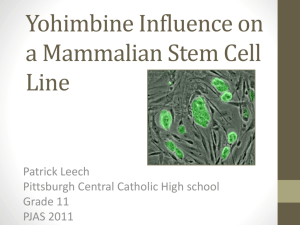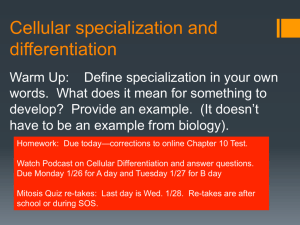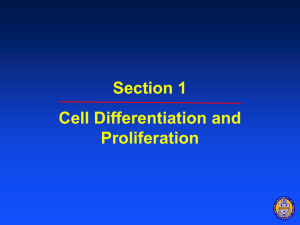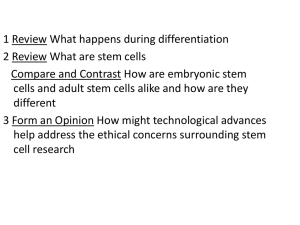Jack Leech C2C12 PJAS ppt 2011
advertisement
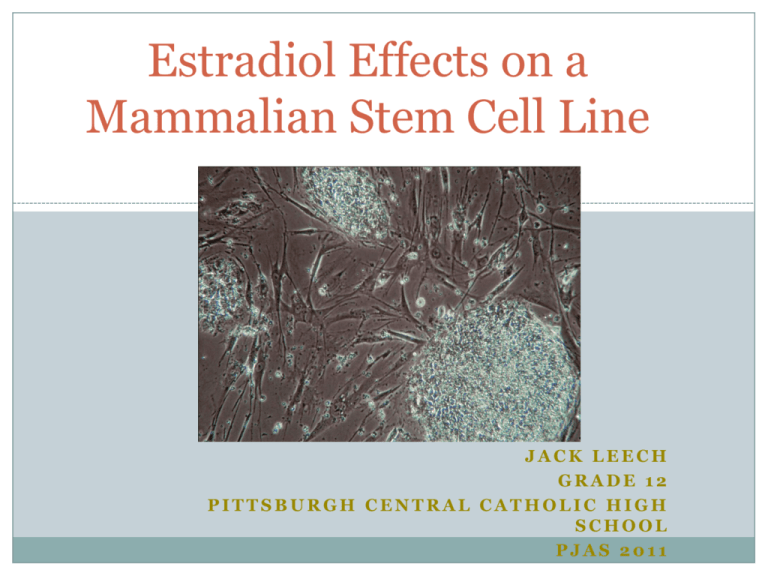
Estradiol Effects on a Mammalian Stem Cell Line JACK LEECH GRADE 12 PITTSBURGH CENTRAL CATHOLIC HIGH SCHOOL PJAS 2011 Stem Cells and Tissue Engineering Tissue Engineering (TE) is the science concerned with improving, restoring, or maintaining the quality of life via artificially created tissues and organs. TE has the potential to create new tissues that have been lost or damaged due to disease, hereditary defects, trauma, etc. With respect to this project, TE technology has been shown to be heavily involved with muscle growth. Targets of Tissue Engineering Cells ECM Defection Hormones Regeneration Blood Supply C2C12 Stem Cell Line Subclone of the mus musculus (mouse) myoblast cell line. A model type of stem cell line that was discovered in 1977 through experimentation of murine thigh muscle growth after a crush injury. Differentiates rapidly, forming contractile myotubes and produces characteristic muscle proteins. Expresses muscle proteins and the androgen receptor (AR). AR- DNA binding transcription factor which regulates gene expression. Estradiol The variable estradiol is the major sex hormone in females, and present in smaller amounts in males. Accounts for female secondary sex characteristics. Steroid hormone (Passes through cellular and nuclear membranes and affects transcription). Estradiol often associated with activation of certain oncogenes, often promoting uterine or breast cancer. Purpose The purpose of this study is to observe the effects of the estrogen estradiol on the proliferation, differentiation, and survivorship of C2C12 stem cells. Hypothesis Null Hypothesis: The addition of the estrogen estradiol WILL NOT affect the proliferation, differentiation, and survivorship of C2C12 stem cells. Alternate Hypothesis: The addition of the estrogen estradiol WILL significantly affect the proliferation, differentiation, and survivorship of C2C12 stem cells. Materials Cryotank 75mm2 tissue culture treated flasks Twenty 25 mm2 tissue culture treated flasks Fetal bovine serum (FBS) C2C12 Myoblastic Stem Cell Line Trypsin-EDTA Pen/strep Macropipette + sterile macropipette tips (1 mL, 5 mL, 10, mL, 20 mL) Micropipettes + sterile tips DMEM Serum - 1% and Complete Media (4 mM L-glutamine, 4500 mg/L glucose, 1 mM sodium pyruvate, and 1500 mg/L sodium bicarbonate + [ 10% fetal bovine serum for complete]) Estradiol (powder) 75 mL culture flask Incubator Nikon Inverted Microscope Aspirating Vacuum Line Laminar Flow Hood Laminar Flow Hood UV Sterilizing Lamp Labeling Tape Hemocytometer Sterile PBS Ethanol (70% and 100%) Distilled water Procedure (Culturing the Cells) A 1 mL aliquot of C2C12 cells from a Cryotank was used to inoculate 30 mL of 10% serum DMEM media in a 75mm2 culture flask yielding a cell density of approximately 106 to 2x106 cells. The media was replaced with 15 mL of fresh media to remove cryo-freezing fluid and incubated (37° C, 5% CO2) for 2 days until a cell density of approximately 4x106 to 5x106 cells/mL was reached. The culture was passed into 3 flasks in preparation for experiment and incubated for 2 days at 37° C, 5% CO2. Procedure (Addition of Variable on Day 0) After trypsinization, cells from all of the flasks were pooled into 1 common 75mm2 flask (cell density of approximately 1 million cells/mL). 0.1 mL of the cell suspension was added to 20 25 mm2 tissue culture treated flasks containing 5 mL of DMEM (com) media, creating a cell density of approximately 105 cells per flask. The stock solution of estradiol (10-3) was created using 10 mL of ethanol and 0.027 grams of estradiol. This was then used in a serial dilution to create a 10-4 concentration. The 10-6 M concentration was created from 50uL of the stock into 5000uL of ethanol, and the 10-8 M concentrations was created from 5uL of a 10-5 stock into 5000uL of ethanol. 10-6 M is the suggested working concentration of the estrogen. The cells were incubated at 37°C, 5% CO2 for the remainder of the study. Two flasks from each group were used in the Proliferation Experiment and two flasks from each group were used in the Differentiation Experiment. Procedure (Proliferation Experiment) Day 1 Using one flask from each group, cell densities were determined as follows: The cells were trypsinized and collected into cell suspension. 25 µl aliquots were transferred to a Hemocytometer for quantification (four counts per flask). Day 1 and Day 3 The previous procedure for determining densities was used again, and a Nikon Inverted Microscope was used to take images of five representative areas of each flask. Procedure (Differentiation Experiment) Day 1 and Day 6 Using the Nikon Inverted Microscope, images of five representative areas of each of the flasks were taken. Day 1 The original media was removed and replaced with 1% DMEM media (serum starvation) to induce myotube differentiation. Results of Proliferation Analysis p-value: 1.08*10^-4 Cell Count (cells/flask) 160000 140000 120000 100000 Day 1 80000 Day2 60000 40000 20000 0 Control 10^-6 Concentration of Variable 10^-8 Statistical Analyses of the Proliferation Results ANOVA Compares variation within groups to variation between groups. Using the ANOVA, a p-value less than the alpha of .05 was gathered (significant variation). Reject the null hypothesis. Dunnett’s test Compares each experimental group to control individually. 0.05 alpha was used, and the t-value compared to the tcritical value of 3.03 Dunnett’s Test Results (cont.) Concentration t-value t-critical (.05) t-critical (.01) Variation 10-6 7.645 3.03 4.63 Significant 10-8 4.709 3.03 4.63 Significant Differentiation Analysis Control Day 1 Day 6 Differentiation Analysis 10-6 Concentration Day 1 Day 6 Differentiation Analysis 10-8 Concentration Day 1 Day 6 Conclusions Proliferation: Based upon the results gathered from the ANOVA and Dunnett’s statistical analyses, it appears that the addition of estradiol significantly affected the proliferation of C2C12 cells. Differentiation: Based upon the images gathered from the inverted microscope, although differentiation was observed, the analysis was qualitative and variance could not be statistically compared. Speculatively, it appeared that little difference was noticed between the control and the various concentrations. Limitations Possible sources of error: The methods of analysis for the proliferation assay were qualitative (hemocytometer). A solution is to use a fluorescent dye that could be used quantify cell counts, and a trypan blue exclusion assay could be used to measure only live cells. The methods of analysis for the differentiation assay were also qualitative (inverted microscope imaging). A solution is to use a quantitative method of analysis, such as MyoD tagging. Extensions (cont.) Use a wider range of concentrations. Determine a LD 50% concentration of the hormone. Use quantitative analyses. Works Cited Dr. Phil Campbell Conrad M. Zapanta, Ph.D. Biomedical Engineering Laboratory, Carnegie Mellon University Mark Krotec, PTEI www.PTEI.org www.tissue-engineering.net
